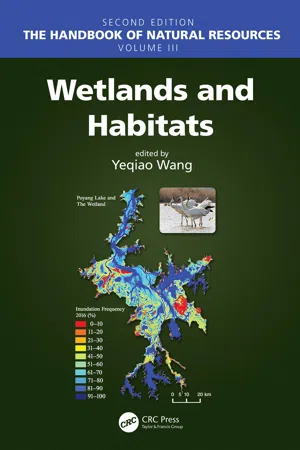
- 272 pages
- English
- ePUB (mobile friendly)
- Available on iOS & Android
Wetlands and Habitats
About This Book
Authored by world-class scientists and scholars, The Handbook of Natural Resources, Second Edition, is an excellent reference for understanding the consequences of changing natural resources to the degradation of ecological integrity and the sustainability of life. Based on the content of the bestselling and CHOICE-awarded Encyclopedia of Natural Resources, this new edition demonstrates the major challenges that the society is facing for the sustainability of all well-being on the planet Earth. The experience, evidence, methods, and models used in studying natural resources are presented in six stand-alone volumes, arranged along the main systems of land, water, and air. It reviews state-of-the-art knowledge, highlights advances made in different areas, and provides guidance for the appropriate use of remote sensing and geospatial data with field-based measurements in the study of natural resources.
Volume 3, Wetlands and Habitats, provides fundamental information on wetlands and their integral functions as a productive ecosystem. The topics it covers include wetlands biodiversity, wetlands classification and monitoring, floods, river ecosystems, pollution, and more. New to this edition are discussions on wetland vegetation, assessment of current wetland health status, restoration, sea-level rises and coastal storm, vulnerability to human impacts, and lakes and wetlands remote sensing. This volume demonstrates the key processes, methods, and models used through many case studies from around the world.
Written in an easy-to-reference manner, The Handbook of Natural Resources, Second Edition, as individual volumes or as a complete set, is an essential reading for anyone looking for a deeper understanding of the science and management of natural resources. Public and private libraries, educational and research institutions, scientists, scholars, and resource managers will benefit enormously from this set. Individual volumes and chapters can also be used in a wide variety of both graduate and undergraduate courses in environmental science and natural science at different levels and disciplines, such as biology, geography, earth system science, and ecology.
Frequently asked questions
Information
I
Riparian Zone and Management
1
Floodplain Management
Historical Approaches

Floodplain Management
- Floodplain mapping.
- Land use regulations.
- Preservation of floodprone open space.
- Flood control (levees, reservoirs, channel modifications, etc.)
- Acquiring and clearing damaged or damage-prone areas.
- Floodproofing buildings to reduce their susceptibility to damage by floodwaters.
- Flood insurance.
- Water quality best management practices.
- Flood warning and response.
- Wetland protection programs.
- Public information.
The National Flood Insurance Program

Other Federal Programs
- Disaster assistance programs that help flooded communities and property owners recover after a flood.
- Mitigation assistance programs that fund local projects to acquire and clear floodprone properties.
- Research and technical assistance activities in the fields of mapping, planning, mitigation, and floodproofing.
- The National Dam Safety Program which assists state programs that regulate dams (dam failures were a factor in three of the four largest killer floods since 1970).
Table of contents
- Cover
- Half Title
- Series Page
- Title Page
- Copyright Page
- Table of Contents
- Preface
- About The Handbook of Natural Resources
- Acknowledgments
- Aims and Scope
- Editor
- Contributors
- Section I Riparian Zone and Management
- Section II Wetland Ecosystem
- Section III Wetland Assessment and Monitoring
- Index